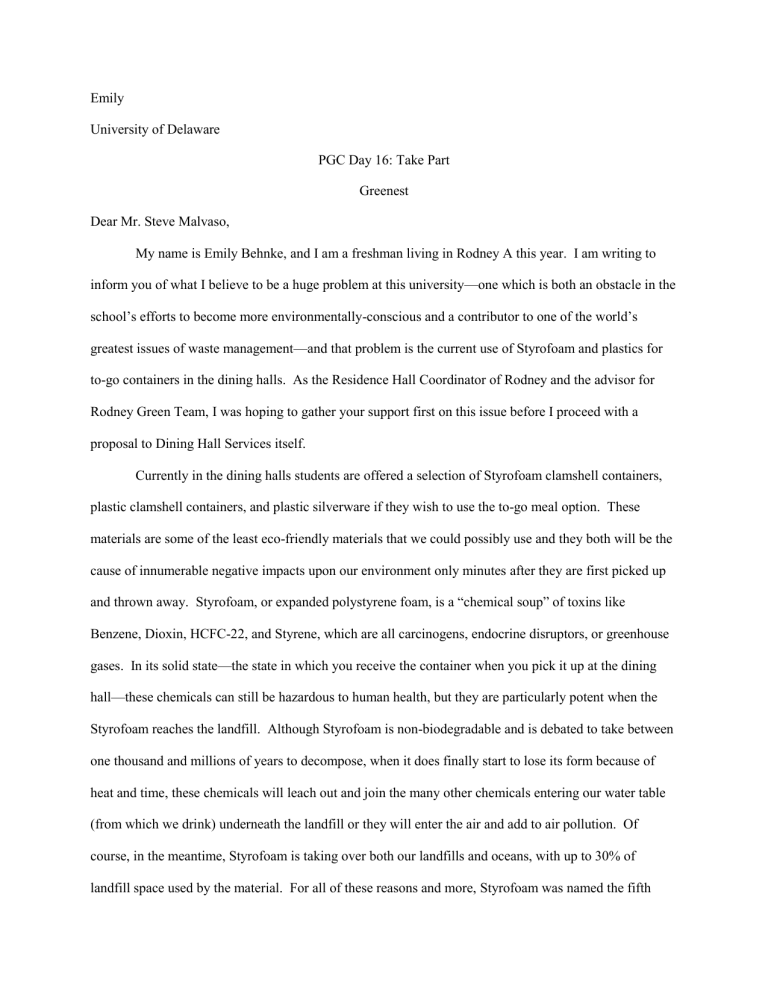Emily-Behnke-Greenest1

Emily
University of Delaware
PGC Day 16: Take Part
Greenest
Dear Mr. Steve Malvaso,
My name is Emily Behnke, and I am a freshman living in Rodney A this year. I am writing to inform you of what I believe to be a huge problem at this university—one which is both an obstacle in the school’s efforts to become more environmentally-conscious and a contributor to one of the world’s greatest issues of waste management—and that problem is the current use of Styrofoam and plastics for to-go containers in the dining halls. As the Residence Hall Coordinator of Rodney and the advisor for
Rodney Green Team, I was hoping to gather your support first on this issue before I proceed with a proposal to Dining Hall Services itself.
Currently in the dining halls students are offered a selection of Styrofoam clamshell containers, plastic clamshell containers, and plastic silverware if they wish to use the to-go meal option. These materials are some of the least eco-friendly materials that we could possibly use and they both will be the cause of innumerable negative impacts upon our environment only minutes after they are first picked up and thrown away. Styrofoam, or expanded polystyrene foam, is a “chemical soup” of toxins like
Benzene, Dioxin, HCFC-22, and Styrene, which are all carcinogens, endocrine disruptors, or greenhouse gases. In its solid state—the state in which you receive the container when you pick it up at the dining hall—these chemicals can still be hazardous to human health, but they are particularly potent when the
Styrofoam reaches the landfill. Although Styrofoam is non-biodegradable and is debated to take between one thousand and millions of years to decompose, when it does finally start to lose its form because of heat and time, these chemicals will leach out and join the many other chemicals entering our water table
(from which we drink) underneath the landfill or they will enter the air and add to air pollution. Of course, in the meantime, Styrofoam is taking over both our landfills and oceans, with up to 30% of landfill space used by the material. For all of these reasons and more, Styrofoam was named the fifth
most hazardous material by the EPA, and yet the product continues to be purchased and provided by our university.
Plastic is the other party in this problem because, while it doesn’t have quite the same shelf-life as
Styrofoam and it is recyclable (if people choose for it to be), it is equally as negative for the environment and human health. Like Styrofoam, plastic is a petroleum-based product, and in fact 8% of the world’s oil production goes toward the production of plastic. Also similar to Styrofoam, plastic is made with a variety of chemicals that, when in contact with humans, will leach into their bodies, and when in a landfill, will leach into the water supply. One of the worst chemicals is BPA, a chemical which today, because of our reliance on plastic, is present in 92% of humans over age 6; this is something to be concerned about because people with the highest levels of BPA face an increased risk for heart disease and diabetes. As far as the environmental impact, although plastic is recyclable, only a small percentage of it is actually recycled, which means plastic now makes up 10% of all generated waste and is the largest contributor of waste to the oceans. This means that plastic is also the largest culprit in the deaths of
100,000 ocean mammals and 1 million sea birds after they ingest the waste. None of these problems are going away anytime soon at the current rate, either, since 300 million tons of plastic is produced around the world every year, and not one piece of that plastic or any other that has ever existed is yet decomposed.
At this point, with all that is known about the detrimental impacts of Styrofoam and plastic, and with the University of Delaware’s desire to create a reputation for itself as a green school, I am pretty shocked that these materials continue to be used on a daily basis by some of the 7,000 students in residence halls on campus. The fact that we still rely on these and don’t even address them as environmental and health hazards means we are consistently negating any other progress we make as a school in the area of environmental sustainability. Fortunately, there’s a rather simple fix. Several universities across the country have implemented eco-to-go programs whereby students sign up for and use reusable containers for their to-go option. While this is probably the most eco-friendly option, UD has other concerns with outside contaminants entering the dining facility, and these could be
compromised by such a system. Rather, I suggest we begin purchasing biodegradable and/or compostable to-go containers and utensils so that they were still disposable and convenient, but also not as long-lasting as Styrofoam or plastic. I recommend the company Biodegradablestore.com, which sells a variety of ecofriendly, biodegradable meal containers in bulk. Their Renewable and Compostable Sugarcane clamshells are $71 for 500, their sugarcane paperboard Food Trays are $48 for 1000, and their Recycled
Content Cutlery is $45 for 1000. I would need further information about our dining hall’s own budget and the current amount they spend on to-go materials to see how this compares, but even if the sustainable solution is more expensive, I highly suggest the university considers the switch for the sake of the students’ health, the environment’s health, and the university’s own credibility.
Thank you,
Emily Behnke http://www.megafaunadesign.com/http:/www.megafaunadesign.com/styrofoam http://greenlivingideas.com/2011/08/01/plastic-world-infographic/









